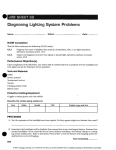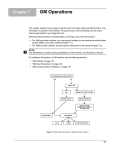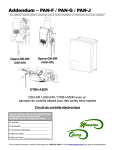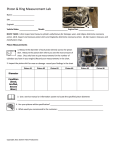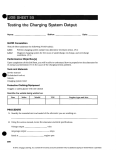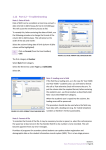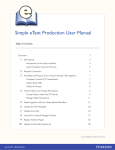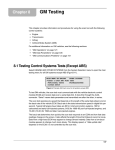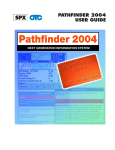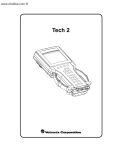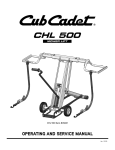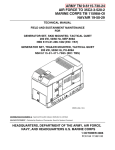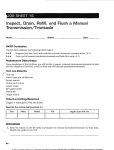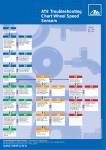Download Lesson Plan - Jame Halderman
Transcript
A5 BRAKES 6th Edition Chapter 20 ABS Diagnosis and Service Opening Your Class KEY ELEMENT EXAMPLES Introduce Content This course or class covers operation and service of Automotive Brakes. It correlates material to task lists specified by ASE and NATEF. Explain how the knowledge of how something works translates into the ability to use that knowledge to figure why the engine does not work correctly and how this saves diagnosis time, which translates into more money. Motivate Learners State the learning objectives for the chapter or course you are about to cover and explain this is what they should be able to do as a result of attending this session or class. Explain the chapter learning objectives to the students. Establish the Mood or Climate Complete Essentials Clarify and Establish Knowledge Base Provide a WELCOME, Avoid put downs and bad jokes. 1. Identify and describe Bendix antilock braking systems. 2. Explain the operation and components of Bosch antilock braking systems. 3. Describe the operation of Delphi antilock braking systems. 4. Identify and describe Kelsey-Hayes antilock braking systems. 5. Describe the operation and components of Teves antilock braking systems. 6. Identify and describe Toyota rear-wheel and four-wheel antilock braking systems. Restrooms, breaks, registration, tests, etc. Do a round robin of the class by going around the room and having each student give their backgrounds, years of experience, family, hobbies, career goals, or anything they want to share. ICONS Ch20 ABS Diagnosis and Service 1. SLIDE 1 ABS DIAGNOSIS & SERVICE 2. SLIDES 2-3 EXPLAIN OBJECTIVES Check for ADDITIONAL VIDEOS & ANIMATIONS @ http://www.jameshalderman.com/ WEB SITE IS CONSTANTLY UPDATED ABS Traction Control (44 Links) VIDEOS 4. SLIDE 4 EXPLAIN ABS Diagnostic Procedure 5. SLIDE 5 EXPLAIN Figure 20-1 On most vehicles equipped with ABS, the amber ABS and red BRAKE warning lamp should come on as a bulb check when the ignition is first switched on. DISCUSSION: DISCUSS PROCEDURE FOR DIAGNOSING A FAULT IN ABS. ASK STUDENTS TO TALK ABOUT WHAT RED BRAKE WARNING LAMP (RBWL) INDICATES WHEN IT IS ILLUMINATED. WHAT ABS PROBLEMS DOES IT SIGNAL? ASK STUDENTS TO DISCUSS OPERATION OF AMBER ABS WARNING LAMP. DEMONSTRATION: SHOW STUDENTS HOW ABS DIAGNOSTICS WORKS ON THE TRAINER 6. SLIDE 6 EXPLAIN Figure 20-2 A thorough visual inspection should include carefully inspecting around the electrohydraulic unit for signs of obvious problems or the installation of aftermarket devices such as alarm systems. DEMONSTRATION: SHOW HOW TO DO A VISUAL INSPECTION LOOKING FOR TELLTALE CLUES OF HOW VEHICLE HAS BEEN DRIVEN & MAINTAINED. DISCUSSION: HAVE STUDENTS TALK ABOUT THE IMPORTANCE OF DOING A COMPLETE VISUAL INSPECTION OF THE ENTIRE VEHICLE BEFORE MAKING A DIAGNOSIS ICONS Ch20 ABS Diagnosis and Service HANDS-ON TASK: HAVE STUDENTS PERFORM A COMPLETE VISUAL INSPECTION OF THE ANTILOCK BRAKING SYSTEM. DISCUSSION: ASK STUDENTS TO TALK ABOUT THE IMPORTANCE OF A TEST DRIVE IN DIAGNOSING AN ABS FAULT. WHAT SYMPTOMS SHOULD TECHNICIANS LOOK FOR IN SUCH A TEST? DEMONSTRATION: SHOW HOW TO RETRIEVE ABS-RELATED DIAGNOSTIC CODES BY USING A SCAN TOOL. ASK THEM TO EXPLAIN THE RESULTS. 7. SLIDES 7-8 EXPLAIN Kelsey-Hayes Antilock (Nonintegral) DISCUSSION: ASK STUDENTS TO DISCUSS THE PROCEDURES FOR CLEARING THE DIAGNOSTIC TROUBLE CODES FOR THE VEHICLES ON WHICH THEY ARE WORKING. 9. SLIDE 9 EXPLAIN Figure 20-3 GM diagnostic connector on a pre- 1996 vehicle. Flash codes are available by using jumper wire to ground (terminal A) to terminal H. 10. SLIDE 10 EXPLAIN Figure 20-4 Connecting a jumper wire from the diagnostic connector to ground. The exact location of this diagnostic connector varies with the exact vehicle model and year. ANIMATION: ABS DTC RETRIEVAL WWW.MYAUTOMOTIVELAB.COM L HTTP://MEDIA.PEARSONCMG.COM/PH/CHET/CHET_MYAUTOMOTIVELAB_2/ BRAKES/AUTO_ANIMATIONS/CH19_FIG19_3/INDEX.HTM 11. SLIDE 11 EXPLAIN Figure 20-5 Chrysler diagnostic connector location varies with model & year. 12. SLIDE 12 EXPLAIN Bosch 2 ABS (Nonintegral) 13. SLIDE 13 EXPLAIN Teves Mark IV DISCUSSION: ASK STUDENTS TO DISCUSS THE ANTILOCK BRAKING SYSTEMS COVERED IN THIS CHAPTER. WHAT ARE THE ADVANTAGES AND DISADVANTAGES OF EACH TECHNOLOGY? ON WHAT TYPES OF VEHICLES DO YOU TYPICALLY FIND EACH SYSTEM? 14. SLIDE 14 EXPLAIN Figure 20-6 A scan tool is the recommended method to use to access General Motors Teves Mark IV systems. 15. SLIDES 15-16 EXPLAIN Delphi (Delco) ABS-VI (Nonintegral) 17. SLIDE 17 EXPLAIN Figure 20–7 Delphi (Delco) VI attaches to the side of the master cylinder and connects hydraulically through transfer tube assemblies. DEMONSTRATION: DEMO WHEEL SENSOR OPERATION 18. SLIDE 18 EXPLAIN Figure 20-8 breakout box is being used to diagnose an ABS problem. The controller (computer) is located in the trunk of this vehicle, and a digital multimeter is being used to measure resistance and voltage at various points in the system, following the service manual procedure. 19. SLIDE 19 EXPLAIN Figure 20-9 Typical wheel speed sensor. When a tooth on the sensor ring is close to the sensor, the strength of the magnetic field is stronger because the metal of the tooth conducts magnetic lines of force better than air. When the tooth moves away, the magnetic field strength is reduced. It is this changing magnetic field strength that produces the changing voltage. Frequency of the signal is determined by the speed of the rotating sensor. DEMONSTRATION: SHOW STUDENTS HOW TO INSPECT THE CONNECTIONS INVOLVED IN THE WHEEL SPEED SENSOR CIRCUIT FOR DEFECTS AND CORROSION. DISCUSSION: ASK STUDENTS TO TALK ABOUT THE PROBLEMS CAUSED BY DAMAGED OR CONTAMINATED WHEEL SPEED SENSORS (WSS). WHAT ARE THE POSSIBLE CAUSES OF LOW VOLTAGE READINGS? HANDS-ON TASK: HAVE STUDENTS PERFORM STEPS IN THE QUICK AND EASY WHEEL SPEED SENSOR DIAGNOSIS TO TEST FOR A FAULT IN WHEEL SPEED SENSOR. 20. SLIDE 20 EXPLAIN Figure 20-10 Measuring the resistance of a wheel speed sensor 21. SLIDE 21 EXPLAIN Figure 20-11 A scope can be used to check for proper operation of a wheel speed sensor & EXPLAIN Figure 20-12 A broken tooth on a wheel speed sensor tone ring shows on the scope trace as a missing wave DEMONSTRATION: SHOW STUDENTS HOW TO TEST A WSS BY USING A SCOPE. HANDS-ON TASK: HAVE STUDENTS TEST A WSS BY USING A SCOPE ON A LAB VEHICLE 22. SLIDE 22 EXPLAIN Figure 20-13 Use a nonmagnetic brass or plastic feeler gauge to check wheel speed sensor gap. A steel gauge would be attracted by magnet in sensor and would produce a drag on the gauge as it is moved between the sensor and the tone ring. This drag could be interpreted as a correct clearance reading. DISCUSSION: ASK STUDENTS TO DISCUSS THE PROCEDURES FOR ADJUSTING WHEEL SPEED SENSORS. WHAT IS THE SIGNIFICANCE OF THE PAPER OR PLASTIC PROTECTIVE COVERING ON THE TIP END OF A WSS? 23. SLIDE 23 EXPLAIN Figure 20-14 (a) Always use a nonferrous (brass or plastic) feeler (thickness) gauge when measuring the gap between the toothed ring and the wheel speed sensor. (b) Sometimes a sensor is equipped with a paper spacer that is the exact thickness of the spacing required between the toothed ring and the sensor. If equipped, the sensor is simply installed with the paper touching the toothed wheel. A typical gap ranges from 0.020 to 0.050 in. (0.5 to 1.3 mm) DEMONSTRATION: SHOW STUDENTS HOW TO USE A NONMAGNETIC FEELER GAUGE TO CHECK THE WHEEL SPEED SENSOR GAP. HANDS-ON TASK: HAVE STUDENTS USE A NONMAGNETIC FEELER GAUGE TO CHECK THE WHEEL SPEED SENSOR GAP ON A LAB VEHICLE ON-VEHICLE NATEF TASK: TEST, DIAGNOSE, AND SERVICE ABS WHEEL SPEED SENSORS. VIDEO: ABS LAMP DIAGNOSIS WWW.MYAUTOMOTIVELAB.COM HTTP://MEDIA.PEARSONCMG.COM/PH/CHET/CHET_MYLABS/AKAMAI/TEMPLATE/VIDEO640X480.PH P?TITLE=ABS%20DASH%20LAMP&CLIP=PANDC/CHET/2012/AUTOMOTIVE/A5F3.MOV&CAPTION=CHET/CHET_MYLABS/AKAMAI/2012/AUTOMOTIVE/XML/A5-F3.ADB.XML VIDEO: .5 MINUTES: ABS CODE DIAGNOSIS WWW.MYAUTOMOTIVELAB.COM HTTP://MEDIA.PEARSONCMG.COM/PH/CHET/CHET_MYLABS/AKAMAI/TEMPLATE/VIDEO640X480.PH P?TITLE=RETRIEVING%20TROUBLE%20CODES&CLIP=PANDC/CHET/2012/AUTOMOTIVE/A5F4.MOV&CAPTION=CHET/CHET_MYLABS/AKAMAI/2012/AUTOMOTIVE/XML/A5-F4.ADB.XML 24. SLIDE 24 ABS EXPLAIN HYDRUALIC SERVICE 25. SLIDE 25 EXPLAIN FIGURE 20–15 Special bleed valve tools are often required when bleeding some ABS units such as the Kelsey-Hayes 4WAL system. 26. SLIDE 26 EXPLAIN FIGURE 20–16 Two bleed valve tools are needed to bleed the Kelsey-Hayes 4WAL system, which attach to the bleeder valves on the accumulator. 27. SLIDE 27 EXPLAIN FIGURE 20–17 To perform an automated brake bleed procedure on an antilock braking system, first connect a factory or enhanced scan tool to the data link connector (DLC) located under the dash on this vehicle. 28. SLIDE 28 EXPLAIN FIGURE 20–18 Access the menu that includes antilock brake system (ABS) functions 29. SLIDE 29 EXPLAIN FIGURE 20–19 Scroll through the menus and select automated bleed procedure and follow the on-screen instructions. HANDS-ON TASK: HAVE STUDENTS USE A SCAN TOOL TO TEST A WSS AND EXPLAIN THE RESULTS. DEMONSTRATION: SHOW STUDENTS HOW TO MAKE CERTAIN THAT THE ABS SYSTEM IS NOT PRESSURIZED BEFORE YOU OPEN A BLEEDER SCREW OR LOOSEN A HYDRAULIC LINE. ON-VEHICLE NATEF TASK: IDENTIFY AND INSPECT ELECTRONIC BRAKE CONTROL SYSTEM COMPONENTS; DETERMINE NECESSARY ACTION ON-VEHICLE NATEF TASK: DIAGNOSE ELECTRONIC BRAKE SYSTEM FAULTS; DETERMINE NECESSARY ACTION ON-VEHICLE NATEF TASK: BLEED ELECTRONIC BRAKE CONTROL SYSTEM HYDRAULIC CIRCUITS. ON-VEHICLE NATEF TASK: REMOVE AND INSTALL ELECTRONIC BRAKE CONTROL SYSTEM ELECTRICAL/ELECTRONIC AND HYDRAULIC COMPONENTS 30. SLIDES 30-32 EXPLAIN SUMMARY ON-VEHICLE NATEF TASK: DIAGNOSE ELECTRONIC BRAKE CONTROL SYSTEM BRAKING CONCERNS CAUSED BY VEHICLE MODIFICATIONS (TIRE SIZE, CURB HEIGHT, FINAL DRIVE RATIO) SEARCH INTERNET: HAVE STUDENTS USE INTERNET TO RESEARCH THREE VEHICLE ANTILOCK BRAKING SYSTEMS. ASK THEM TO WRITE A BRIEF DESCRIPTION OF THE ABS TECHNOLOGY USED FOR EACH VEHICLE AND THE ADDITIONAL COST OF THIS OPTION.







